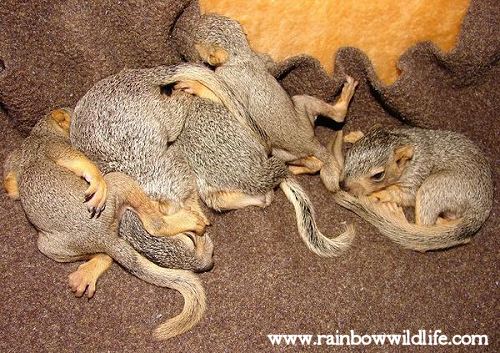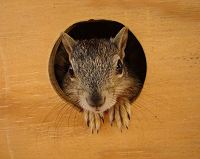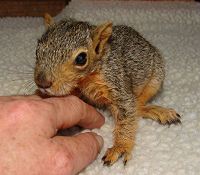| |
|
|
Know your Neighborhood Wildlife - The Squirrel
by BIRGIT SOMMER
February 17, 2009
Orphaned baby squirrels
Squirrels endangered by natural disaster, injury or who have become separated from their parents may require human intervention or rescue. There are many key mistakes that people make when trying to rescue a baby squirrel. Although these tiny babies are adorable, they are not domesticated and do not make good pets. As a matter of fact, it is illegal in most states to possess a squirrel without the necessary permits.

Orphaned fox squirrel babies being cared for at the Rainbow Wildlife Rescue in Texas.
|
|
|
|
A typical scenario: A pile of leaves, crushed by February’s gusty winds and winter frosts, suddenly becomes a temporary home for a fluffy baby squirrel that has fallen from its nest and lies still in wait for its Mother to find it. Slowly the baby starts getting chilled and with mom nowhere in sight, the chances for this baby’s survival without proper human intervention are slim.
I found a baby squirrel, now what?
When dealing with this type of scenario, attempt to reunite the baby with the mom. If you think the mother squirrel may still be in the area and you have a good idea where the nest is located, first give the mother the opportunity to retrieve the baby or babies.
Baby squirrels can not only carry parasites such as fleas and lice, but they can also bite if they are old enough to have teeth, so they should never be handled without gloves!
| Place the infant squirrel in a small box on an old t-shirt (no terry cloth where the little toenails can get hung up) at the base of the tree where it was first found. If there are dogs in the area, place the baby in a basket and tie the basket to the tree out of the dogs’ reach.
If the baby appears healthy and warm, allow 2 hours for the mother to reunite with her young while you observe from a safe distance. Even on hot summer days baby squirrels can get chilled quickly. A soda bottle filled with lukewarm water and covered with a sock can be placed near the baby. Make sure it can’t roll onto the baby and suffocate it by placing old shirts or rags around it. |

Juvenile fox squirrel |
What happens when the Mother does not return for her young or if the baby is visibly injured?
Bring the box containing the baby inside and place it in a dark, warm and quiet place away from children, pets, and loud noises. Limit handling the baby to the absolute minimum and contact a licensed wildlife rehabilitator immediately. Veterinarians will not treat wildlife but usually will refer you to a local rehabilitator instead.
Dehydration is very common when animals first arrive at a rehabilitator facility for treatment, and almost every orphaned baby is dehydrated to some degree. Unflavored Pedialyte, found in the baby aisle of the supermarket, is the best hydrating solution. Homemade rehydration fluid is made by combining 1 teaspoon salt with 3 tablespoons sugar in 1 quart of warm water. Microwaving the fluid is not advised.
Administer the fluid orally with a small 1 cc syringe or a rubber nipple if available. A syringe larger than 3 cc increases the risk of aspirating and drowning the squirrel baby. Holding the baby in an upright position for feeding and rehydrating (never on its back!), feed the baby 1 cc or ml of the hydrating solution every 2 hours, for up to 12 hours if necessary.
A few important safety tips must be observed when feeding squirrels in this way. Liquid coming out of the nose, indicating that the fluids have entered the lungs, could endanger a nursing baby squirrel. If this occurs, stop feeding immediately and allow the baby to clear its lungs by encouraging it to sneeze, because pneumonia will set in if the fluid is not expelled.
 5 weeks old fox squirrel
5 weeks old fox squirrel |
Never ever feed cow’s milk to a squirrel baby! Most baby animals, wild or domesticated, can’t handle the lactose in cow’s milk and develop diarrhea as a result. Most animals in need of human care are already in a compromised health condition and many won’t be able to survive additional digestive problems.
In addition to rehydrating a squirrel baby, it needs to be kept warm. No matter what heating source you use, make sure you give the baby enough room to get away from the heat. Always use the lowest setting of an electric heating pad.If you come across a squirrel with common ailments such as external parasites, visible injuries, or obviously sick, it is critical that you speak with a rehabilitator immediately! |
For additional information on how to deal with orphaned wildlife, or to find licensed wildlife rehabilitators in your area, please visit www.rainbowwildlife.com or www.squirrel-rescue.com.
----------------------------------------------------------------------------
Disclaimer: The information provided in this article is the property of the Rainbow Wildlife Rescue. The RWR holds all copyright interests in such material, unless specifically indicated. Permission to reprint is given with credit to the Rainbow Wildlife Rescue and noted authors.
|
|
|